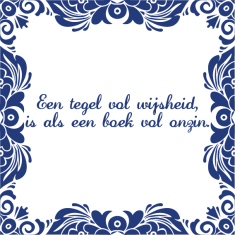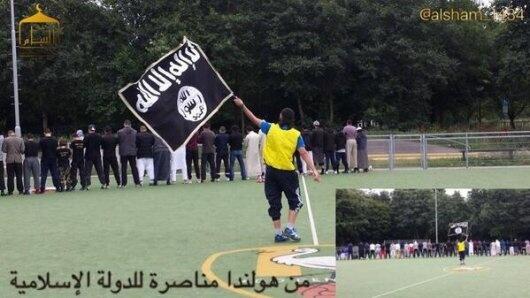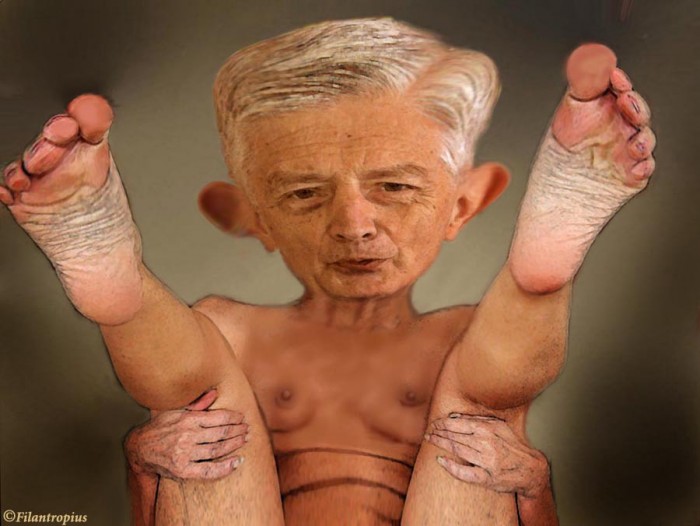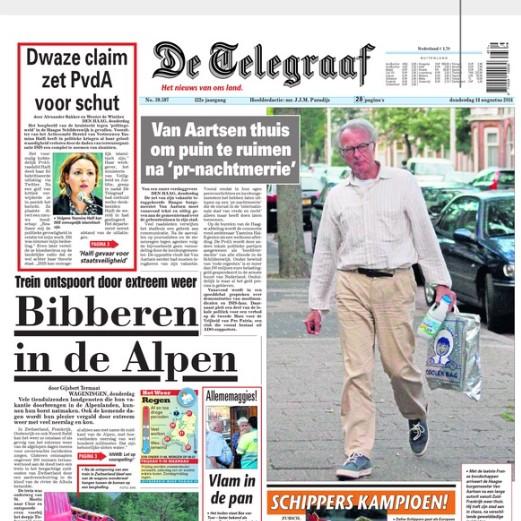Eis het ontslag van Jozias van Aartsen
![]() Neem contact op met de schrijver van de petitie
Neem contact op met de schrijver van de petitie
Dit discussie-onderwerp is automatisch gecreëerd voor petitie Eis het ontslag van Jozias van Aartsen.
|
Kies een pseudoniem |
#7876 Palestine [bron: Encyclopædia Brittanica]2014-08-20 15:10Palestine, area of the eastern Mediterranean region, comprising parts of modern Israel and the Palestinian territories of the Gaza Strip (along the coast of the Mediterranean Sea) and the West Bank (the area west of the Jordan River). The term Palestine has been associated variously and sometimes controversially with this small region, which some have asserted also includes Jordan. Both the geographic area designated by the name and the political status of it have changed over the course of some three millennia. The region (or at least a part of it) is also known as the Holy Land and is held sacred among Jews, Christians, and Muslims. Since the 20th century it has been the object of conflicting claims of Jewish and Arab national movements, and the conflict has led to prolonged violence and, in several instances, open warfare. The word Palestine derives from Philistia, the name given by Greek writers to the land of the Philistines, who in the 12th century bc occupied a small pocket of land on the southern coast, between modern Tel Aviv–Yafo and Gaza. The name was revived by the Romans in the 2nd century ad in “Syria Palaestina,” designating the southern portion of the province of Syria, and made its way thence into Arabic, where it has been used to describe the region at least since the early Islamic era. After Roman times the name had no official status until after World War I and the end of rule by the Ottoman Empire, when it was adopted for one of the regions mandated to Great Britain; in addition to an area roughly comprising present-day Israel and the West Bank, the mandate included the territory east of the Jordan River now constituting the Hashimite Kingdom of Jordan, which Britain placed under an administration separate from that of Palestine immediately after receiving the mandate for the territory. The name Palestine has long been in popular use as a general term to denote a traditional region, but this usage does not imply precise boundaries. The perception of what constitutes Palestine’s eastern boundary has been especially fluid, although the boundary frequently has been perceived as lying east of the Jordan River, extending at times to the edge of the Arabian Desert. In contemporary understanding, however, Palestine is generally defined as a region bounded on the east by the Jordan River, on the north by the border between modern Israel and Lebanon, on the west by theMediterranean Sea (including the coast of Gaza), and on the south by the Negev, with its southernmost extension reaching the Gulf of Aqaba. The strategic importance of the area is immense: through it pass the main roads from Egypt to Syria and from the Mediterranean to the hills beyond the Jordan River. Settlement depends closely on water, which is almost never abundant. Precipitation, which arrives in the cool half of the year, decreases in amount in general from north to south and from the coast inland. Perennial rivers are few, and the shortage of water is aggravated by the porous nature of the limestone rocks over much of the country. For further reading on the political units most closely associated with Palestine, see the articles Egypt,Israel, Jordan, and Lebanon. LandCoastal lowlands of varying widths front the Mediterranean. The most northerly is the Plain of ʿAkko (Acre), which extends with a breadth of 5 to 9 miles (8 to 14 km) for about 20 miles (32 km) from the Lebanon border in the north to the Carmel promontory, in Israel, in the south, where it narrows to a mere 600 feet (180 metres). Farther southward the lowland opens out rapidly into the Plain of Sharon, about 8 miles (13 km) wide and extending south to the latitude of Tel Aviv–Yafo. Once covered with marshes, the Sharon plain was reclaimed in the post-Exilic and Hellenistic period and is now a settled area. Fields and fruit groves are laid out between scattered sandstone ridges, on which villages have grown up. South of the spur of low hills that approaches the coast at about Yafo (Jaffa), the plain widens into a fertile region known in biblical times as Philistia, a district of orange groves, irrigated orchards, and fields of grain. Farther northward the Plain of Esdraelon (ʿEmeq Yizreʿel), formed by subsidence along lines of faults, separates the hills of southern Galilee from the mountains of Samaria. The plain, 16 miles (26 km) wide at most, narrows to the northwest, where the Qishon River breaks through to the Plain of ʿAkko, and to the southeast, where the Ḥarod River—which rises at the Spring of Ḥarod—has carved the plain into the side of the Jordan Valley. Covered with rich basaltic soils washed down from the Galilean hills, Esdraelon is important both for its fertility and for the great highway it opens from the Mediterranean to the lands across the Jordan. The maritime plain connects with Esdraelon by the pass of Megiddo and several lesser routes between the mountain spurs of Carmel and Gilboaʿ. The hill country of Galilee is better-watered and more thickly wooded than that of Samaria or Judaea. North of the Bet Netofa Valley (Plain of Asochis) is Upper Galilee, with elevations of 4,000 feet (1,200 metres), a scrub-covered limestone plateau that is thinly populated. To the south, Lower Galilee—with its highest peak, Mount Tabor (1,929 feet [588 metres])—is a land of east-west ridges enclosing sheltered vales like that of Nazareth, with rich basaltic soils. Samaria, the region of the ancient kingdom of Israel, is a hilly district extending from the Plain of Esdraelon to the latitude of Rām Allāh. Its mountains—Carmel, Gilboaʿ, Aybāl (Ebal), and Al-Ṭūr (Gerizim)—are lower than those of Upper Galilee, while its basins, notably those of the ʿArrābah Plain and Nābulus, are wider and more gently contoured than their equivalents in Judaea. Samaria is easily approached from the coast across the Plain of Sharon and from the Jordan by the Fāriʿah valley. The city of Jerusalem has expanded rapidly along the mountain ridges. From Rām Allāh in the north to Beersheba in the south, the high plateau of Judaea is a rocky wilderness of limestone, with rare patches of cultivation, as found around Al-Bīrah and Hebron. It is separated from the coastal plain by a longitudinal fosse and a belt of low hills of soft chalky limestone, about 5 to 8 miles (8 to 13 km) wide, known as Ha-Shefela. The Judaean plateau falls abruptly to the Jordan Valley, which is approached with difficulty along the wadis Kelt and Mukallik. The Jordan Valley is a deep rift valley that varies in width from 1.5 to 14 miles (2.5 to 22 km). In its northern section the bed of the drained Lake Ḥula and of Lake Tiberias (the Sea of Galilee) are blocked by natural dams of basalt. Descending to about 1,310 feet (400 metres) below sea level—the lowest land depth on the Earth’s surface—the valley is exceedingly dry and hot, and cultivation is restricted to irrigated areas or rare oases, as at Jericho or at ʿEn Gedi by the shore of the Dead Sea. The Negev, a desertlike region, is triangular in shape with the apex at the south. It extends from Beersheba in the north, where 8 inches (200 mm) or more of precipitation falls annually and grain is grown, to the port city of Elat on the Red Sea, in the extremely arid south. It is bounded by the Sinai Peninsula on the west and the northern extension of the Great Rift Valley on the east.
http://www.britannica.com/EBchecked/topic/439645/Palestine
Nu duidelijk, idioot? Er zijn nog zesentwintig pagina's, maar die spaar ik je. |
|
Gast |
#7877 Re:2014-08-20 15:15Laat hem nu daadwerkelijk een moslim citeren om zijn gelijk te halen. In Keulen heeft het gedonderd. |
|
Gast |
#7878 De technologische prestaties van het kleine Israel. Daar kan Hamas iets van leren.2014-08-20 15:29Israel is qua omvang kleiner dan Nederland , en heeft maar 7.000.000 inwoners. Veel minder dan Rusland (145 miljoen) of het islamitische Pakistan (130 miljoen inwoners). Desondanks staat Israël op de vierde plaats in de wereld voor wat betreft wetenschappelijke activiteit, gemeten aan de hand van het aantal wetenschappelijke publicaties per miljoen inwoners per jaar. In 1998 werd Tel Aviv door het Amerikaanse Newsweek genoemd als een van de tien meest technologisch invloedrijke steden in de wereld.
Duurzaamheid Het gebrek aan conventionele energiebronnen zoals olie en gas heeft in Israel geleid tot uitgebreid onderzoek en ontwikkeling van alternatieve energiebronnen. Israël is daardoor een van de voorlopers in innovatieve technologieën op het gebied van zonne-energie en electrische auto’s. In 2009 werd Israel – in een rapport van de Cleantech Group – geplaatst in de top 10 van landen met de meest schone technologieopwekking.
Ruimtevaart In 2009 Israël werd gerangschikt onder de top 20 landen in de ruimtevaart wetenschap, in een onderzoek door het bureau Thomson Reuters. Israël is een van de weinige landen dat satellieten kan lanceren; deze worden in Israel zelf ontworpen en gefrabiceerd. Israel wordt het derde land met een ruimtevaartuig op de maan.
Agrarische wetenschap Voor Israël, dat voor tweederde uit woestijn bestaat, zijn waterbesparende technologieën van cruciaal belang. De International Water Association heeft Israël genoemd als een van de leidinggevende landen in innovatieve methoden voor waterbehoud. De moderne technologie van druppelirrigatie werd uitgevonden in Israël. De jaarlijkse melkproductie per koe is het hoogste ter wereld, ruim 10.000 liter (gemiddeld ruim 6.000 in de EU).
Drinkwater In Israel wordt 70% van het water gerecycled. Dat is drie keer zo veel als welk ander land dan ook. De Ashkelon zeewater omgekeerde osmose (SWRO) ontziltingsinstallatie was de grootste in de wereld op het moment dat deze werd gebouwd. Israel bouwt zo veel zeewater-ontziltingsinstallaties dat deze vanaf 2013 de helft van de waterbehoefte leveren. Israel zal dan een zoetwater-overschat hebben.
High tech Israëlische bedrijven blinken uit in computer beveiligingstechnologieën, halfgeleiders en datacommunicatie. De zeer hoge concentratie van high-tech industrieën in de kustvlakte van Israël heeft geleid tot de bijnaam Silicon Wadi. Even wat voorbeelden: De Intel’s Core Duo processor die tegenwoordig in bijna alle computers zit is ontwikkeld in Israel. Apple, Intel en Microsoft bouwden hun eerste onderzoeks- en ontwikkelingscentra buiten de VS in Israël. Andere high-tech multi-nationale bedrijven, zoals IBM, Cisco Systems en Motorola hebben eveneens fabrieken in Israel. Israel telt meer dan 3.850 startende technologie bedrijven, alleen de VS zijn groter in deze sector. Israel heeft ook het grootste aantal NASDAQ (technologie aandelenbeurs) genoteerde bedrijven buiten Noord-Amerika – meer dan alle Europese landen bij elkaar. High tech maakt momenteel al 35% van Israels export uit.
Militaire techniek Opmerkelijke technologie omvat het Uzi machinepistool, de Merkava tank en de gezamenlijk ontworpen Israëlische en Amerikaanse Arrow raket, een van de meest geavanceerde anti-ballistische raketsystemen. Het Iron Dome mobiele luchtverdedigingssysteem is ontwikkeld in Israel om korte afstand raketten en artilleriegranaten te onderscheppen. Het systeem is opgezet als een defensieve tegenmaatregel om de raketdreiging tegen de burgerbevolking van Israël aan de noordelijke- en zuidelijke grenzen tegen de gaan. En zo de radicaal-islamitische terreurorganisaties Hamas en Hezebollah terreurwapens te ontnemen.
Gezondheid Israel heeft een geavanceerde sector van medisch en paramedisch onderzoek en bio-technogologie. Biotechnologisch-, biomedisch- en klinisch onderzoek levert meer dan de helft van de wetenschappelijke publicaties van het land op, en veel nieuwe therapieen om mensen (sneller) beter te maken. De commerciele sector gebruikt deze uitgebreide kennis voor de ontwikkeling van farmaceutische producten en medische apparatuur. Israel neemt inmiddels de vijfde plaats in de wereld in voor levensverwachting, hoger dan Nederland en met 81,6 jaar (cijfer 2009) ruim 2 jaar hoger dan het gemiddelde in de Westerse wereld.
Economie Door de nadruk op moderne technologie is de Israelische economie ongevoelig gebleken voor de economische crisis die sinds 2008 met name de EU verlamd. De economie blijft groeien met 5% per jaar.
Fundamenteel wetenschappelijk onderzoek Israel heeft zeven universiteiten waaar wetenschappelijk onderzoek plaats vindt. Israëlische universiteiten worden gerangschikt onder de top 100 academische instellingen in de wereld in de volgende wetenschappelijke disciplines: in de natuurkunde (3 universiteiten), in de chemie (ook 3 universiteiten), in de informatica (4 universiteiten, waarvan2 inde top 20); in de wiskunde en natuurwetenschappen (3 universiteiten), in de techniek (1 universiteit) en in de medicijnen (1 universiteit). In de laatste tien jaar hebben 6 Israeli’s een Nobelprijs gewonnen. Dit komt mede doordat Israel wereldwijd aan kop staat voor wat betreft de uitgaven aan wetenschappelijk onderzoek per hoofd van de bevolking, met 1.273 dollar per inwoner. De USA staan op de tweede plaats met 1.206 dollar en Japan derde met 1.153 dollar per inwoner. Ter vergelijking: het gemiddelde bedrag dat per inwoner in de Arabische landen aan de wetenscahp wordt besteed is slechts 14.7 dollar per inwoner…….
Conclusie
|
|
Gast |
#7879 Re: Re:2014-08-20 15:30 |
|
Gast |
#7880 Re: Re:2014-08-20 15:35 |
|
Gast |
#7881 Re: Re: Re:2014-08-20 15:37Nou, dan dank je wel voor een stortvloed aan antwoorden. |
|
Gast |
#7882 Re: Re: Re: Re:2014-08-20 15:37 |
|
Voor wie het werkelijke artikel wil lezen |
#7883 Schumpeter — Beyond the start-up nation2014-08-20 15:41ISRAELIS tell a joke about a Jew who takes to reading Arab newspapers. A friend, puzzled, asks him why. If I read the Israeli papers, all I hear is bad news about the Jews, he replies; but the Arab papers constantly claim we are all rich and successful, and rule the world. These days the hero of the tale has another source of good news about Israel: the business press. Over the past two decades Israel has been transformed from a semisocialist backwater into a high-tech superpower. Adjust for population and Israel leads the world in the number of high-tech start-ups and the size of the venture-capital industry. Twenty years ago Harvard Business School's leading guru, Michael Porter, devoted just one sentence of his 855-page “The Competitive Advantage of Nations” to Israel; today there is a growing pile of books on Israel's high-tech boom, most notably “Start-Up Nation: The Story of Israel's Economic Miracle”, by Dan Senor and Saul Singer. Israelis are rightly proud of their high-tech miracle. They lap up books like “Start-Up Nation” and delight in talking about their country's successful IPOs. They are also proud of how it was one of the last countries to enter recession and among the earliest to exit: the economy grew by more than 4% in the year to September. But for all its success the Israeli boom nevertheless raises a number of troubling questions. First, does the economy rest on too narrow a base? High-tech industries employ only 10% of the workforce but account for 40% of exports. Second, why has Israel proved so bad at turning start-ups into domestic giants? It has 3,800 high-tech start-ups but only four high-tech companies with sales of more than $1 billion a year. Third, is Israel capable of producing content for the internet as well as just the hardware and software that constitutes its “plumbing”? And, fourth, why has the land of the high-tech miracle got one of the rich world's lowest labour-participation rates, just 55%? These questions all add up to one bigger one. Is the Israeli miracle sustainable? Or did it result from a peculiar combination of circumstances in the 1990s? One good sign is the emergence of some Israeli companies that are concentrating on providing content for the internet rather than just the plumbing. JVP, a venture-capital company with more than $820m under management, focuses on developing companies that fuse content with technology. Erel Margalit, the firm's founder, argues that Israel has as much of a comparative advantage in culture as in high-tech: the Jews, he points out, have always excelled in telling stories. Although Jerusalem, where Mr Margalit is based, is synonymous in many people's minds with endless cultural and religious conflict, he argues that it nevertheless stands to benefit from being the meeting-point of three great civilisations.Israel's policymakers are well aware of all this, and are thinking hard about the solutions. They have identified a number of areas with high growth potential, such as water management, agricultural science, alternative energy and of course security, in which Israel already has world-beating technology. In the life sciences, the government is seeking to speed up the creation of firms by setting up venture-capital funds. However, Israeli officials worry that the country is still lagging in its ability to “turn tomato seeds into tomatoes”—to transform start-ups into the sort of giants, like Google and Cisco, that Silicon Valley regularly produces. Such giants, they note, create a greater proportion of high-paying jobs than start-ups. They also worry that Israeli entrepreneurs are taking longer than they used to in turning an idea into an IPO. Going beyond Israel's “Start-Up Nation” model will not be easy. The country's business culture focuses more on dealmaking than on company-building. The army's technological prowess, which provided the know-how behind many a start-up, does not translate as well into providing the internet with content as it did in providing it with plumbing. Israel also has much better links with America and Europe than with the rising powers of Asia. From strength to strength There are nevertheless reasons for thinking that Israel's strengths will endure. The government is trying to apply the venture-capital approach that it applied so successfully to start-ups (igniting private-sector creativity rather than picking winners) to late-stage financing. The army is more than a high-tech incubator. It sifts the entire population for talent, giving the most promising techies intensive training in elite units, and inculcates an ethic of self-reliance and problem-solving. Israel is also good at the sort of technological mash-ups that produce exciting new industries. The inspiration for camera pills (which transmit pictures from inside the human body) came from missiles that can “see” their targets, and the inspiration for heart stents came from drip-irrigation systems. The country has long turned adversity into a source of competitive advantage. For example, it became a world leader in alternative fuel partly because it was surrounded by hostile oil-rich countries. However, the main obstacle to Israel's long-term economic success has nothing to do with how it creates firms. It lies in its failure to assimilate into its business culture both Arab-Israelis and ultra-orthodox Jews, who will together be about one-third of the population by 2025. Only 39% of ultra-Orthodox men and 25% of Arab women are employed. Think-tanks such as the Milken Institute are trying to encourage small businesses in Arab-majority areas such as Galilee and the Negev. Both these economic problems will only be solved by political will: Israel needs to work harder at dealing with its internal Arab problem; and it needs to tell its ultra-orthodox Jews that, however hard they pray, the rest of the country does not owe them a living.
|
|
Gast |
#7884 Demo-verbod in alle Haagse wijken2014-08-20 15:57 De komende twee maanden mag er in
geen enkele Haagse woonwijk worden
gedemonstreerd door groepen die voor of
tegen de jihadistische strijd zijn. Dat
schrijft burgemeester Van Aartsen in
een brief aan de gemeenteraad.
Vorige week kondigde Van Aartsen al een
demonstratieverbod af voor alleen de
Schilderswijk. In de brief schrijft hij
nu dat er, om rellen te voorkomen, in
ieder geval de komende twee maanden in
beginsel niet in woonwijken mag worden
gedemonstreerd pro- of anti-IS.
Betogen mag wel op locaties die volgens
Van Aartsen beter geschikt zijn. Welke
dat zijn, staat niet in de brief. |
|
Gast |
#7886 Van Aarsten is een lafaard en moet opstappen.2014-08-20 16:14#7884: - Demo-verbod in alle Haagse wijken ISIS IS DUS DE BAAS IN DE SCHILDERSWIJK. VAN AARTSEN = GROTE LAFAARD.
|
|
Gast |
#7887 Re: Schumpeter — Beyond the start-up nation2014-08-20 16:17#7883: Voor wie het werkelijke artikel wil lezen - Schumpeter — Beyond the start-up nation Het is net als die Van Agt en die verlepte
|
|
Gast |
#78892014-08-20 16:22Bloedtest om kanker vroegtijdig op te sporenIsraëlische wetenschappers hebben een nieuwe bloedtest ontwikkeld die het mogelijk maakt om kanker op te sporen nog voordat de ziekte uitbreekt. |
|
Gast |
#7890 Israël in vogelvlucht: wetenschap en technologie2014-08-20 16:25Israël in vogelvlucht: wetenschap en technologieHet verlangen om een achtergesteld land in een moderne staat om te vormen was een sleutelfactor in Israëls wetenschappelijk onderzoek en technologische ontwikkeling. Aanvankelijk richtte onderzoek op projecten van nationaal belang. Nu behoren het percentage en het geld gespendeerd in vergelijking tot het Bruto Nationaal Produkt, tot de hoogste in de wereld. Research And Development op universiteitenIsraëls grote reservoir van gekwalificeerd personeel is voornamelijk verantwoordelijk voor haar wetenschappelijk en technologische prestaties met meer dan 80 procent van al het gepubliceerd onderzoek uitgevoerd door Israëls universiteiten. Het grote aantal patenten genomen door de universiteiten is indicatief voor hun relatie met de industrie en de vestiging van wetenschappelijke industrieparken verbonden aan universiteitcampussen heeft grote commercieel succes. Universiteiten hebben ook 'spin-off' industriële bedrijven voor de commercialisering van specifieke produkten opgezet gebaseerd op hun onderzoek, vaak in samenwerking met lokale en buitenlandse concerns. Medische Research And DevelopmentBiotechnologie, biomedisch en klinisch onderzoek beslaan meer dan de helft van alle wetenschappelijke publikaties. Lokale wetenschappers hebben methoden ontwikkeld voor het voortbrengen van een menselijk groei hormoon, interferon (een groep proteïne effectief tegen virale infecties) en Copaxone, een medicijn effectief in de behandeling van multiplesclerose. Genetische manipulatie, inclusief klonen, hebben geresulteerd in een breed bereik van diagnostische uitrusting gebaseerd op monoklonale antilichamen, samen met andere microbiologische produkten. Verfijnde medische uitrusting voor zowel diagnostische en behandelingsdoeleinden zijn ontwikkeld en over de hele wereld verspreid, zoals computertomografie (CT) scanners, magnetische resonantie beelden (MRI) systemen, ultrasound scanners, nucleaire medische camera's, operatie lasers en een miniatuur camera in een doorslikbare pil gebruikt om gastro-intestinale ziekte te diagnoseren. Industriële Research And DevelopmentIsraëls industriële R&D, met een hoge concentratie op electronica, wordt voornamelijk uitgedragen door een klein aantal grote bedrijven. Deze R&D-intensieve bedrijven zijn een grote bron geweest van industriële werkgelegenheid en export door de jaren heen. De eerste Israëlische astronautOp het gebied van aeronautics, zijn lokaal ontworpen en gefabriceerde satellieten geproduceerd en gelanceerd door Israëls Luchtvaart Industrie in samenwerking met het Israëlische Ruimtevaart Agentschap. Daarnaast ontwikkelt, bouwt en exporteert Israël grote aantallen gerelateerde items zoals displaysystemen, aeronautische computers, instrumentele systemen en vliegsimulatoren. Ook is Israël een wereldleider in technologie en produktie van drones. Israëls eerste astronaut, Kolonel Ilan Ramon kwam tragisch om het leven met zes NASA collega's bij terugkeer van de space shuttle Colombia in de atmosfeer van de aarde. Agrarische Research And DevelopmentHet optimaal gebruik maken van schaars water, woestijnachtig land en beperkte arbeidskracht heeft geleid tot revoluties in agrarische methoden. Agrarische R&D wordt hoofdzakelijk uitgevoerd door het Ministerie van Landbouw Agrarische Onderzoeks Organisatie, met onderzoeksresultaten snel uitgezonden door een uitgebreid diensten systeem waarbij fouten en problemen direct naar wetenschappers worden gebracht voor oplossingen. Energie Research & DevelopmentUitgebreide ontwikkeling van alternatieve energie bronnen zoals zonne-, thermische en windenergie is het positieve resultaat van het ontbreken van conventionele energiebronnen. Israël is een leider op het gebied van zonneënergie en de werelds grootste gebruiker per hoofd van zonnewaterverwarming in huis. Recentelijk is een nieuwe hoog efficiënte ontvanger om geconcentreerde zonlicht te verzamelen ontwikkeld die het gebruik van zonneënergie in de industrie ook zal vermeerderen. Een voordeel in windenergie is de produktie van een windturbine met een flexibel, inflatable rotor. Een project ontwikkeld door een team van wetenschappers aan het Technion gebruikt droge lucht en water om energie te produceren door 1000 meter hoge schoorstenen. |
|
Gast |
#78912014-08-20 16:28
|
|
Gast |
#7892 Zie hier de laatste wetenschappelijke bijdrage van de islam :-)2014-08-20 16:29
|
|
Gast |
#78932014-08-20 16:37Adeeb Alblooshi, 10, Dubai, United Arab Emirates It was a trip to the beach that sparked Adeeb Alblooshi's inventing career. When his father -- who had suffered from polio -- could not go swimming because of his prosthetic leg, Adeeb, then six, made him a waterproof alternative using an enhanced medical wax coating. Soon after, he created a small vibrating robot to help his mother clean small spaces. It wasn't long before the media, and subsequently the Dubai government, came calling. With the government's supervision and funding, he's come up with five more inventions since then, including a seat belt that monitors a passenger's heart rate and alerts the authorities when it's too high or low. Since April, he's been on an international scientific tour with the Emirates Institution for Advanced Science and Technology, which has had him attending academic conferences, meeting with researchers, and even attending space camp at the U.S. Space & Rocket Center in Alabama. "I've learned a lot, but most importantly, I'm having fun while doing it," he says.
http://edition.cnn.com/2014/08/14/health/8-whiz-kids-future-medicine/index.html?iref=allsearch
En wat was jouw bijdrage aan de maatschappij ook weer? O ja, andermans tekstjes en fotootjes plakken. Blijf lekker fröbelen, jongen, je komt er wel. |
|
Gast |
#7894 Israël is energie-onafhankelijk door aardgasvondsten2014-08-20 16:42en Israel is World Leader in Recycled WaterWith 70% of its sewage water recycled, Israel leads the world in water reuse, and is advancing with desalination of sea water as well. |
|
Gast |
#7895 Re: Israël is energie-onafhankelijk door aardgasvondsten2014-08-20 16:43#7894: - Israël is energie-onafhankelijk door aardgasvondsten Je realiseert, hoop ik toch, dat titel en tekst helemaal niets met elkaar te maken hebben? Alweer kortsluiting? |
|
Gast |
#78962014-08-20 16:45 Josh Meier, een erg slimme Joodse jongen inderdaad. |
|
Gast |
#7897 Re: Re: Israël is energie-onafhankelijk door aardgasvondsten2014-08-20 16:46 |
|
Gast |
#7898 Re:2014-08-20 17:01
Je krijgt ACHT kinderen/jonge mensen voorgeschoteld die iets gepresteerd hebben. Jij wil er maar één zien. Nog maar eens de vraag, randdebiel: WIE KIJKT ER WEG?
|
|
Gast |
#78992014-08-20 17:04Laat hem lekker tegeltjes plakken. Is het meest creatieve dat 'ie gedaan heeft. Ooit. |
|
Gast |
#7900 Swedish Jewish Woman Savagely Beaten for Wearing Star of David2014-08-20 17:33
Swedish Jewish Woman Savagely Beaten for Wearing Star of DavidJewish mother of four brutally attacked by Muslim gang who noticed her Star of David necklace. Met dank aan het Moslim gajes in Zweden.
 |
|
Steun KEES van DAAIBOOI BEACH CURACAO
Gort over de grens moet blijven.
Red Nederland: Heropen de Gaswinning!
Open brief aan de Belgische regering - Leg de lat hoger: stop de blokkade, stop de genocide
EINDE CORONA CRISIS: Overheid sta behandeling van COVID-19 met HCQ en zink en / of Ivermectine toe!
Voor een realistische snelheid van 90km/u op de Houtlaan in Wijnegem!
Zwembad het Baafje Heiloo moet open blijven!
De St. Victorkerk behouden voor ontmoetingen.
Respecteer de euthanasiewet
Wij willen een eerlijke boer.inn.enlandbouw!
Behoud Losloopgebieden voor Honden op de Utrechtse Heuvelrug, in Austerlitz, en Zeist
Geen Noodopvang / AZC op het Hocrasterrein te Bussum
Gelijkwaardigherstel mag niet stoppen!
Wij eisen het intrekken van de huidige vergunningen van de Fourwinds Policedog center in Geffen!
Castratie-/sterilisatieplicht huiskatten Nederland
Is er iets dat u wilt veranderen?
Verandering vindt niet plaats door te zwijgen. De auteur van deze petitie stond op en ondernam actie. Zult u hetzelfde doen? Start een sociale beweging door een petitie aan te maken.
Start uw eigen petitieAndere petities waarin u mogelijk geïnteresseerd bent
WAP-PETITIE WOLF - VOOR VEILIGHEID VAN MENS & DIER
7932 Gemaakt: 2025-08-25
Red Onze Motocross Oefenterreinen in België
3052 Gemaakt: 2025-07-23
Opvang Sprookjesland: stem van de ouders!
423 Gemaakt: 2025-08-29
Meningen over het voorgestelde Asielzoekerscentrum in Venlo.
4420 Gemaakt: 2024-07-07
HLN, stop Luc Bellings foute HORECA-beoordelingen te laten geven
311 Gemaakt: 2025-08-25
NEE tegen een AZC Hoorn
3369 Gemaakt: 2024-09-21
Geen uitbreiding fietszone Brugge
614 Gemaakt: 2025-08-23
Kortsnuiten Blijven Bestaan
3922 Gemaakt: 2024-10-23
Erkenning stilgeboren kindje
191 Gemaakt: 2025-08-23
STOP de waanzin voor een TIJDELIJKE snelweg ivm werken aan de A8 te Halle!!
1067 Gemaakt: 2025-08-03
Kinderdagverblijf Nadine moet open blijven!
98 Gemaakt: 2025-08-31
Stop uitbreiding kruispunt R11/Prins Boudewijnlaan-Red de berm, onze leefbaarheid en gezondheid
1398 Gemaakt: 2025-02-21
Behoud voortbestaan Stationslocatie kermis Voorhout
339 Gemaakt: 2024-07-16
AZC Dordrecht
601 Gemaakt: 2024-01-04
Laat onze zeeklassen toch doorgaan!
70 Gemaakt: 2025-08-31
Pak ons buitenzwembad niet af!
2191 Gemaakt: 2025-06-02
Bescherm ouders en kinderen tegen onzichtbaar Emotioneel en psychisch geweld kinderen – Justitie moet verantwoordelijkheid nemen
39 Gemaakt: 2025-08-31
Gsm verbod weg!
36 Gemaakt: 2025-09-02
Steun een kledingbeleid waarin veilig en vrij bewegen en kleden vanzelfsprekend is
90 Gemaakt: 2025-08-27
Arthurito B2B Just Jeff: Boxer-Editie 🩳✅
29 Gemaakt: 2025-08-27
 #7877: - Re:
#7877: - Re:  #7877: - Re:
#7877: - Re:  #7881: - Re: Re: Re:
#7881: - Re: Re: Re: 

 griezel Gretta daar klopt ook niets meer van. Beide lijken dement te zijn.
griezel Gretta daar klopt ook niets meer van. Beide lijken dement te zijn.

 #7895: - Re: Israël is energie-onafhankelijk door aardgasvondsten
#7895: - Re: Israël is energie-onafhankelijk door aardgasvondsten